Xinhua News Agency, Beijing, August 29th-the State Council Press Office released a white paper entitled "Energy Transformation in China" on August 29th. The full text is as follows:
China’s Energy Transformation
(August 2024)
People’s Republic of China (PRC)
the State Council Information Office
catalogue
foreword
First, the road to energy transformation in China in the new era
(A) energy transformation is the only way
(2) Unswervingly accelerate energy transformation.
(C) China has made remarkable achievements in energy transformation and development.
Second, the background color of green consumption of thick planting energy
(A) to strengthen energy conservation and carbon reduction system constraints
(2) Promote energy conservation and efficiency improvement in key areas.
(C) Cultivate a new mode of green energy consumption
Third, accelerate the construction of a new energy supply system
(1) Promote the high-quality development of non-fossil energy.
(2) Promote the coordinated development of traditional energy and new energy.
(3) Improve the toughness of the energy system
Fourth, vigorously develop new energy quality productivity
(A) improve the energy science and technology innovation system
(2) Accelerating energy transformation and scientific and technological innovation
(3) Create a new growth point for upgrading the energy industry
V. Promoting the modernization of energy governance
(1) Building a fair, open and effectively competitive energy market.
(B) to strengthen government guidance and services
(3) Strengthening the legal protection of energy transformation
Sixth, help build a community of human destiny.
(A) China provides new kinetic energy for global green development.
(2) Promote the "One Belt, One Road" green energy cooperation.
(3) jointly promote the sustainable development of global energy.
Concluding remarks
foreword
Energy is an important material basis for human survival and development, and the low-carbon development of energy is related to the future of mankind. Since the industrial revolution, the large-scale development and utilization of fossil energy has strongly promoted the progress of human civilization, but it has also caused problems such as resource depletion, climate change and geopolitical conflicts. It has become the consensus of all countries to accelerate the transformation and development of energy, realize the sustainable utilization of energy, continuously improve the well-being of people’s livelihood and provide inexhaustible motive force for the world economy.
Since the founding of New China 75 years ago, the energy industry has developed rapidly, and China has become the largest energy producer and consumer in the world. Since the 18th National Congress of the Communist Party of China, China energy has entered a new stage of high-quality development. In 2014, General Secretary of the Supreme Leader put forward a new energy security strategy of "four revolutions and one cooperation" to promote energy consumption revolution, supply revolution, technological revolution, system revolution and strengthen international cooperation in all directions, which pointed out the direction of energy development in the new era and provided fundamental follow-up. Under the guidance of the new strategy of energy security, China has embarked on a road of energy transformation that conforms to the national conditions, the global development trend and the requirements of the times.
China’s energy transformation is based on high-quality development, accelerating the construction of a clean, low-carbon, safe and efficient new energy system, providing a strong energy guarantee for economic and social development, and constantly meeting people’s growing needs for a better life.
China’s energy transformation focuses on the construction of ecological civilization, accelerating the formation of a new energy consumption model that is economical, efficient, green and inclusive, promoting carbon reduction, pollution reduction and green growth in coordination, and promoting the harmonious coexistence between man and nature.
China’s energy transformation serves to build a community of human destiny, continuously deepen international cooperation in green energy, actively promote global energy transformation, and join hands with other countries to build a sustainable energy future. China respects developing countries’ independent choice of the transition path in line with national conditions, and promotes energy transformation in a fair, just and orderly manner.
In order to comprehensively introduce the historic achievements of China’s energy transformation in the past ten years and share the practices of China’s energy transformation, this white paper is issued.
First, the road to energy transformation in China in the new era
In today’s world, a new round of scientific and technological revolution and industrial transformation has been further promoted, and green, low-carbon, digital intelligence and sustainable development have become the theme of the times. Countries have different stages of economic development and resource endowments. How to coordinate the safe and stable supply of energy and green and low-carbon transformation is both a common goal and a difficult problem. China put forward a new strategy of energy security, promoted the energy transformation and achieved remarkable results, answered the questions of the world and the times, and showed the rule of China and the responsibility of a big country.
(A) energy transformation is the only way
The development and utilization of energy is an important aspect of the interaction between man and nature. Throughout the development history of human society, every major progress of human civilization is often accompanied by the change of energy development and utilization mode and the replacement of main energy.
After long-term development, China has established an all-round energy supply system of coal, oil, gas, nuclear power, water, wind and light, which provides surging power for sustained and rapid economic and social development. At present, China has embarked on a new journey of building a socialist modern country in an all-round way and put forward new requirements for high-quality energy development. China is the largest developing country in the world, but the per capita energy consumption level is not high, industrialization and urbanization have not been completed, and the energy demand will continue to increase in the future. The industrial structure is biased, the energy structure is biased towards coal, and the constraints of resources and environment exist for a long time. To cope with these difficult challenges, it is essential to rely on energy transformation.
China’s energy transformation, focusing on accelerating the transformation of energy development mode, changing the driving force of energy development, and promoting the replacement of the main energy from fossil energy to non-fossil energy, is an urgent need to break the constraints of resources and environment and achieve the goal of carbon neutrality in peak carbon dioxide emissions; It is an urgent need to seize the opportunity of a new round of scientific and technological and industrial transformation and accelerate the cultivation of new quality productive forces; It is an urgent need to promote the formation of green production methods and lifestyles and achieve high-quality economic and social development; It is an urgent need to take the initiative to assume the responsibility of a big country and promote the building of a community of human destiny. China promotes energy transformation, not because others ask us to do it, but because we have to do it ourselves; It is not whether you can do it or not, but you must do it.
(2) Unswervingly accelerate energy transformation.
In line with the general trend of global energy development, China has unswervingly implemented the new strategy of energy security, focused on promoting the harmonious coexistence between man and nature, creating a new form of human civilization, and promoting the gradual transformation of energy development mode from resource-dependent to innovation-driven, and embarked on a road of energy transformation that conforms to China’s national conditions and meets the requirements of the times. China’s energy transformation adheres to the following principles:
— — Adhere to the people first. Energy is closely related to people’s lives. China adheres to the people-centered development idea, continuously improves the universal service level of energy in the whole society, provides clean and reliable energy use guarantee to better meet people’s needs for a better life, and constantly enhances people’s sense of acquisition, happiness and security.
— — Adhere to green and low carbon. Energy transformation is the key to both green mountains and green hills and Jinshan Yinshan. Adhere to the development path of ecological priority, green and low carbon, strive to promote the harmonious coexistence between man and nature, and regard energy transformation as an important goal of economic and social development. Give priority to saving energy resources, implement a comprehensive saving strategy, make full use of one gram of coal, one drop of oil and one degree of electricity, and continuously improve energy utilization efficiency. Guided by green and low carbon, we will vigorously implement renewable energy substitution and accelerate the construction of an energy supply system with non-fossil energy as the main body.
— — Adhere to the national conditions. The rice bowl of energy must be in our own hands, and we should strengthen our independent energy guarantee ability based on domestic conditions. Adhere to the principle of "establishing before breaking" and overall planning. The gradual withdrawal of traditional energy must be based on the safe and reliable substitution of new energy, strengthen the construction of energy production, supply, storage and marketing system, make up the shortcomings of energy reserve adjustment, give full play to the role of fossil energy as a guarantee, and effectively respond to the challenges of energy security risks.
— — Adhere to innovation and lead. Innovation is the "golden key" to open the door of energy transformation. Accelerate the implementation of innovation-driven development strategy, strengthen key core technology research, accelerate the innovation of energy technology, industry and business model, promote new energy technology and its related industries to become new growth points to promote industrial upgrading, and cultivate and expand new quality productivity. Deepen the reform of energy marketization, give full play to the decisive role of the market in resource allocation, give better play to the role of the government, and stimulate the vitality of various business entities.
— — Adhere to open cooperation. Promoting sustainable development and coping with climate change are common challenges facing mankind. Adhering to the concept of community of human destiny, we will expand high-level opening-up in the energy field, strengthen international cooperation in energy in all directions, and build a new model of green and low-carbon energy transformation and win-win situation. Deeply participate in the global energy governance reform and promote the establishment of a fair, just, balanced and inclusive global energy governance system.
(C) China has made remarkable achievements in energy transformation and development.
In the past ten years, under the guidance of the new strategy of energy security, China has further promoted the transformation of energy production and consumption patterns, comprehensively improved its energy supply guarantee capacity, and achieved a historic breakthrough in energy green and low-carbon development, which effectively guaranteed high-quality economic and social development, better met the people’s growing needs for a better life, and effectively supported the construction of beautiful China.
China’s energy transformation promotes the development of clean energy into the fast lane. In 2023, the proportion of clean energy consumption reached 26.4%, an increase of 10.9 percentage points compared with 2013, and the proportion of coal consumption decreased by 12.1 percentage points. The total installed power generation capacity reached 2.92 billion kilowatts, of which the installed power generation capacity of clean energy reached 1.7 billion kilowatts, accounting for 58.2% of the total installed power generation capacity. The power generation of clean energy is about 3.8 trillion kWh, accounting for 39.7% of the total power generation, an increase of about 15 percentage points over 2013. In the past ten years, the newly-added clean energy power generation accounts for more than half of the increase in electricity consumption in the whole society, and the "green" content of energy in China has been increasing.
China’s energy transformation supports high-quality economic and social development. The energy rice bowl is getting stronger and stronger, and the primary energy production capacity has increased by 35% in ten years, which has strongly supported the steady and healthy development of China’s economy. In the past ten years, the investment in fixed assets in the energy sector has accumulated about 39 trillion yuan, which has significantly boosted the investment growth of upstream and downstream industrial chains and related industries. A series of major projects in the energy field have been completed and put into operation, and a complete energy equipment manufacturing industrial chain has been established. Technological innovations in new energy, hydropower, nuclear power, power transmission and transformation, and new energy storage have been accelerated, which has promoted the clean energy industry to grow into a new pillar of the modern industrial system.
China’s energy transformation ensures people’s needs for a better life. In the past ten years, energy supply and demand have maintained a balance, energy prices have been generally stable, and the energy security of more than 1.4 billion people has been effectively guaranteed. The per capita domestic electricity consumption in China has doubled from about 500 kWh to nearly 1,000 kWh, and the number of natural gas users has reached 560 million, ranking 12th in the World Bank’s global business environment assessment. The energy industry has comprehensively boosted poverty alleviation and rural revitalization. The total investment in rural power grid transformation and upgrading in the central budget exceeds 100 billion yuan, which drives local and enterprises to increase capital investment, and in 2015, the problem of electricity consumption for the population without electricity in the country will be solved historically. The scale of household photovoltaic in rural areas has reached 120 million kilowatts, involving more than 5.5 million farmers, which can increase farmers’ income by 11 billion yuan and create about 2 million jobs every year. Constantly meet the people’s green energy demand. By the end of 2023, the clean heating rate in the northern region was nearly 80%, and the national charging infrastructure increased from less than 100,000 units to nearly 8.6 million units.
China’s energy transformation and high-level protection of ecological environment have been promoted together. In the past ten years, the average coal consumption of coal-fired power supply has dropped to 303 grams of standard coal/kWh, and the emission level of sulfur dioxide and nitrogen oxides of advanced units is equivalent to the limit value of natural gas generating units. In 2013-2023, energy consumption per unit of GDP decreased by more than 26%. Continue to promote the upgrading of refined oil quality, and the quality of refined oil has reached the world advanced level. The number of coal-fired boilers in China has been reduced by more than 80%, and the Beijing-Tianjin-Hebei region and its surrounding areas and Fenwei Plain have basically completed the replacement of loose coal for heating in winter in plain areas. Green intensive development of energy resources has been realized, green development technology has been widely used, and the mine ecological environment has been obviously improved. Popularize the new model of "photovoltaic+"ecological restoration in desert, Gobi, desert and coal mining subsidence area. The average concentration of PM2.5 decreased by 54% and the days of heavy pollution decreased by 83%, which effectively supported the construction of beautiful China.
China’s energy transformation has made important contributions to global energy transformation and building a clean and beautiful world. In 2023, China’s investment in energy transformation reached US$ 676 billion, making it the largest country in the world. In the past ten years, China has provided high-quality clean energy products and services to the world, continuously intensified scientific and technological innovation, and constantly promoted the rapid iteration of new energy technologies, effectively promoting the global cost of wind power and photovoltaic. China continued to expand its open cooperation, and cooperated with more than 100 countries and regions in green energy projects. A large number of landmark projects such as nuclear power, hydropower and new energy were completed and put into operation one after another. In 2023, the export of wind power photovoltaic products helped other countries to reduce carbon dioxide emissions by about 810 million tons. China’s new energy industry not only enriches the global supply and relieves the global inflationary pressure, but also makes outstanding contributions to the global response to climate change and green transformation.
Second, the background color of green consumption of thick planting energy
Green is the background color of ecological civilization. China firmly established and practiced the concept of Lucid waters and lush mountains are invaluable assets, planned the transformation of development mode from the height of harmonious coexistence between man and nature, made great efforts to change the path dependence on energy resources, and promoted the overall green transformation of economic and social development.
(A) to strengthen energy conservation and carbon reduction system constraints
Always adhere to the principle of giving priority to energy conservation, curb unreasonable energy consumption, and make efforts to change the way of resource utilization and improve the efficiency of resource utilization.
Make good use of energy consumption double control baton. Implementing dual control of energy consumption is an important institutional arrangement for China to accelerate the construction of ecological civilization and promote high-quality development. In order to adapt to the new situation of economic and social development, China takes the decrease of energy consumption intensity as a binding indicator, and promotes the transition to dual control of carbon emissions. In the past ten years, through the adjustment, optimization and upgrading of industrial structure, China has made great efforts to develop energy-saving and carbon-reducing technologies and industries, comprehensively improved energy efficiency, and the energy consumption intensity has continued to decline, saving about 1.4 billion tons of standard coal and reducing carbon dioxide emissions by about 3 billion tons.
Construct a three-dimensional energy-saving management system. In-depth implementation of "People’s Republic of China (PRC) Energy Conservation Law", "Circular Economy Promotion Law of the People’s Republic of China" and other laws and regulations, establish and improve the system of energy-saving review and energy-saving supervision of fixed assets investment projects, clarify the energy-saving management requirements of key industries and key enterprises, strengthen the energy-saving management of key energy-using units, implement the "leader" system of energy efficiency, and enhance the endogenous motivation of energy conservation and efficiency improvement of each subject. Give play to the leverage of taxation, finance and other policies, and guide the whole society to increase investment in energy conservation and efficiency improvement.
Innovate market-oriented energy-saving methods. Strengthen the labeling management system of energy efficiency standards, constantly promote the revision of standards in the field of energy conservation, and lead all aspects of energy conservation and efficiency improvement with standards. By the end of 2023, a total of 335 national standards such as energy consumption limits and product energy efficiency have been issued, and energy efficiency labels cover 44 types of energy-using products in five major energy-using fields. Actively promote market-oriented mechanisms such as contract energy management, and promote "one-stop" comprehensive service modes such as energy-saving consultation, diagnosis, design, financing, renovation and trusteeship. In 2023, the total output value of energy-saving service industry exceeded 500 billion yuan, double that of 2013.
(2) Promote energy conservation and efficiency improvement in key areas.
Energy-saving and efficiency-improving should be "hard bones". Industry, construction, transportation and public institutions, as the main body of energy consumption in the whole society, are the "basic disks" for energy conservation and efficiency improvement. Through the full implementation of energy-saving standards, the promotion of advanced energy-efficient products and the elimination of backward production capacity, the energy efficiency level in key areas has been continuously improved.
Dig deep into the energy-saving potential in the industrial field. Industrial enterprises are the top priority of energy conservation and efficiency improvement. We will continue to promote the elimination of backward production capacity and energy-saving technological transformation in the industrial field, actively promote production process innovation, process reengineering and digital intelligent upgrading, and organize key enterprises to improve the refined management level of energy use. In the past ten years, the energy consumption of industrial units above designated size has decreased by more than 36%, and the comprehensive energy consumption of steel, electrolytic aluminum, cement, glass and other unit products has decreased by more than 9% on average.
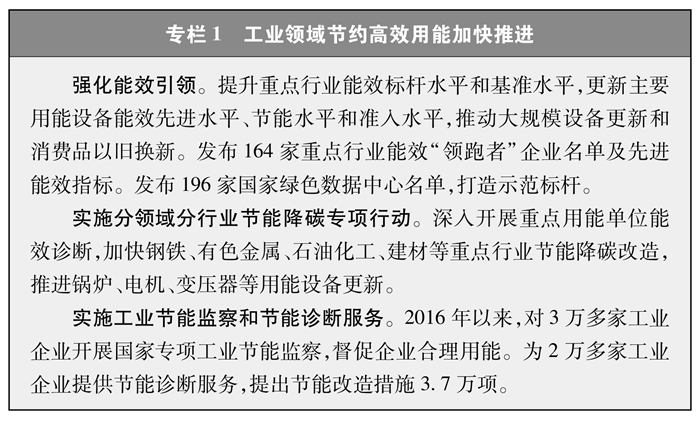
Promote green and energy-saving buildings. China is in the largest urbanization process in the world. In order to avoid the high-carbon lock-in effect, China has strengthened the requirements of energy-saving standards for new buildings, steadily promoted the energy-saving renovation of existing buildings, and accelerated the development of buildings with ultra-low energy consumption and near-zero energy consumption. By the end of 2023, the accumulated energy-saving building area reached 32.68 billion square meters, and energy-saving buildings accounted for more than 64% of the existing urban building area, an increase of nearly 30 percentage points compared with 2013, and the accumulated ultra-low energy consumption and near-zero energy consumption buildings exceeded 43.7 million square meters.
Build a clean and efficient transportation system in all directions. With the development of economy and society, the demand for logistics and travel is increasing, and the energy consumption for transportation will continue to grow. China has accelerated the development of multimodal transport and increased the proportion of railways and waterways in comprehensive transport. Further promote the priority development of urban public transport, build and improve the green travel service system, and promote the application of new energy vehicles in the field of urban passenger transport. Motor vehicle emission standards are in line with the world’s advanced level, and basically eliminate vehicles with national emission standards of three or below. The intensity of transportation energy consumption is declining. In 2023, the comprehensive energy consumption of railway unit transportation workload decreased by about 19% compared with 2013. Vigorously develop the charging infrastructure network and improve the layout and service facilities of hydrogenation and gas filling stations. By the end of 2023, nearly 8.6 million charging infrastructures and more than 450 hydrogen refueling stations had been built.
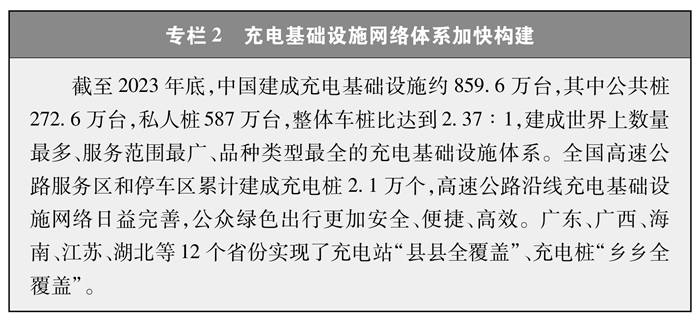
Building economical public institutions. Formulate the Regulations on Energy Conservation of Public Institutions, actively carry out the activities of establishing conservation-oriented institutions and conservation-oriented public institutions, promote the implementation of energy-saving technological transformation by contract energy management, promote the electrification of terminal energy consumption of public institutions, advocate green office and green travel, and give priority to purchasing green energy-saving products. By the end of 2023, 90% of government agencies at or above the county level had built conservation-oriented institutions, and 5,114 demonstration units of conservation-oriented public institutions had been established. In 2023, the comprehensive energy consumption per capita of public institutions in China decreased by 20.4% compared with 2013.
(C) Cultivate a new mode of green energy consumption
China actively guides the whole society to give priority to the use of green energy, vigorously promotes the fine tradition of the Chinese nation of diligence and thrift, and promotes the change of lifestyle and consumption pattern to a simple, moderate, green, low-carbon, civilized and healthy way.
Promote the consumption of renewable energy. The implementation of renewable energy power consumption responsibility weight system, set the annual renewable energy power consumption responsibility target for the administrative regions of provinces (autonomous regions and municipalities directly under the central government), and monitor and evaluate its completion. Establish a renewable energy green power certificate system, and take the green power certificate as the only certificate for energy users to consume green power and the only proof of environmental attributes. Take green electricity consumption as an important basis and content for evaluating, certifying and labeling green products, encourage the whole society to give priority to using green energy and purchasing green products and services, and encourage qualified enterprises to form a low-carbon and zero-carbon energy consumption model. Both the 2022 Beijing Winter Olympics and the 2023 Hangzhou Asian Games will use 100% green electricity.
Promote electrification and low carbonization of terminal energy. The industrial field focuses on production heating, drying and steam supply, and implements electric energy substitution such as high-temperature heat pump and electric heating to promote the demonstration application of hydrogen production from renewable energy in chemical and metallurgical fields. Solar water heaters and electric cookers are widely used in the construction field, and clean heating in the northern region is actively promoted, and clean low-carbon energy such as electricity, natural gas, biomass, geothermal energy and industrial waste heat is promoted to replace coal-fired heating. In 2023, the clean heating rate in the northern region is nearly 80%. Vigorously promote new energy vehicles in the field of transportation, improve the level of railway electrification, and promote the use of shore power for ships and aircraft to dock. By the end of 2023, the number of new energy vehicles in China exceeded 20.4 million, and the proportion of railway electrification in China reached 73.8%. The electrification rate of terminal energy consumption in the whole society is 28%, and the electrification level has increased by about 7 percentage points in the past ten years.
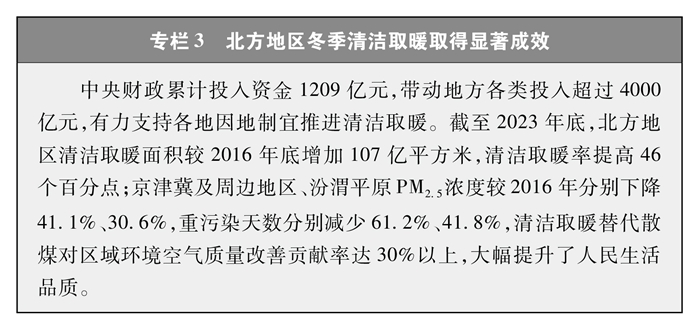
Practice a green and low-carbon lifestyle. Energy saving and carbon reduction is a national action that runs through the whole society. China actively advocates the concept of green and low-carbon life, carries out in-depth actions to create a green life, and promotes the people to continuously raise their awareness of saving. Intensify the promotion of green and low-carbon products, organize and carry out thematic publicity activities such as National Ecological Day, National Energy Conservation Publicity Week, National Low-carbon Day and World Environment Day, and fully popularize energy-saving concepts and knowledge. Encourage the public to travel green, giving priority to public transportation, cycling and walking. Organize 109 cities to carry out green travel creation actions, including 97 cities that have passed the assessment, and the proportion of green travel has reached more than 70%.
Third, accelerate the construction of a new energy supply system
Based on the basic national conditions and development stages, China has grasped the coordination and balance between new energy and traditional energy, and promoted energy transformation while ensuring reliable energy supply. Vigorously improve the reliable substitution ability of non-fossil energy, give play to the supporting and regulating role of fossil energy, and accelerate the construction of a new multi-clean, safe and resilient energy supply system.
(1) Promote the high-quality development of non-fossil energy.
Accelerating the development of non-fossil energy is an inevitable requirement for strengthening the construction of ecological civilization, promoting green and low-carbon economic and social development, and actively and steadily promoting carbon neutrality in peak carbon dioxide emissions, which is the only way to develop green productive forces.
Promote the rapid development of wind power and photovoltaic power generation. China is rich in wind energy and solar energy resources, and wind power and photovoltaic power generation have become the main force of clean energy. We will promote the construction of large-scale wind power photovoltaic bases in an orderly manner, focusing on Kubuqi, Wulanbuhe, Tengger and Badain Jaran deserts, and plan to build 450 million kilowatts of large-scale wind power photovoltaic base projects. Promote the large-scale cluster development of offshore wind power, with a cumulative installed capacity of 37.28 million kilowatts. Actively promote the development of distributed new energy, carry out the "action of controlling wind in thousands of villages and towns" and "action of mu guang in thousands of households", and promote the new model of "photovoltaic+agriculture" such as complementary agriculture, fishery and animal husbandry, which has opened up a broad space for the development of new energy in rural areas. By the end of 2023, the cumulative installed capacity of wind power and photovoltaic power generation in China reached 441 million kilowatts and 609 million kilowatts respectively, a total increase of 10 times compared with 10 years ago. Among them, the cumulative installed capacity of distributed photovoltaic power generation exceeds 250 million kilowatts, accounting for more than 40% of the total installed capacity of photovoltaic power generation.

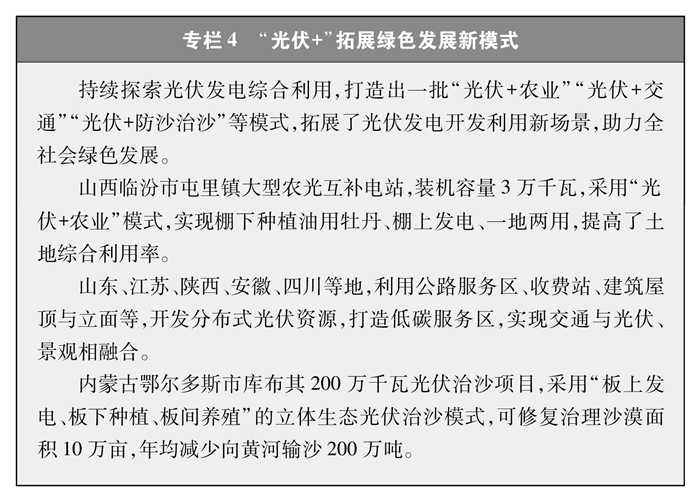
Develop hydropower according to local conditions. Scientifically coordinate hydropower development and ecological protection, and promote the construction of large hydropower bases and the upgrading of large hydropower stations in an orderly manner. By the end of 2023, the installed capacity of conventional hydropower reached 370 million kilowatts. We will steadily promote the green transformation and modernization of small hydropower stations. By the end of 2023, nearly 4,000 small hydropower stations have been transformed and upgraded, and the comprehensive ecological benefits have been significantly improved.
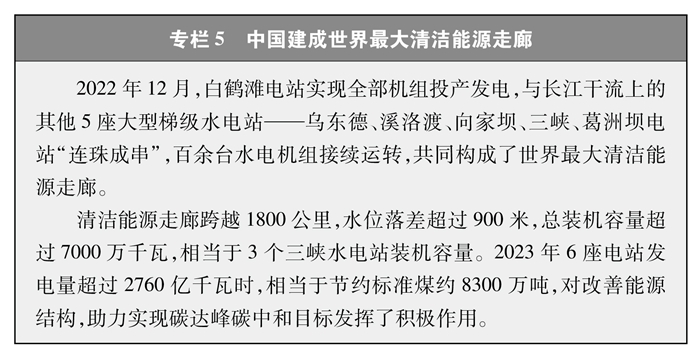
Actively, safely and orderly develop nuclear power. Nuclear power is a clean energy with high quality and high efficiency. China always regards nuclear safety as the lifeline of nuclear power development, insists on adopting the most advanced technology and the strictest standards to develop nuclear power, and maintains the safe and stable operation of nuclear power units in operation for a long time. The construction of coastal nuclear power projects has been promoted in an orderly manner. The first batch of independent third-generation nuclear power technology "Hualong No.1", which represents "China’s business card", has been put into operation one after another. The demonstration project of "Guohe No.1" is under construction, and the world’s first high-temperature gas-cooled reactor demonstration project of the fourth-generation nuclear power technology commercial power station has been completed and put into operation. Breakthroughs have been made in the comprehensive utilization of nuclear energy such as clean heating and heating, and the application fields of nuclear energy have been further expanded. By the end of 2023, the installed capacity of nuclear power in operation was 56.91 million kilowatts, 3.9 times that of the end of 2013; The total installed capacity under construction is 100.33 million kilowatts.
Promote the development of biomass energy, geothermal energy and ocean energy. We will promote the diversified development and utilization of biomass energy according to local conditions, and steadily develop biomass power generation in agriculture and forestry, biogas power generation and municipal solid waste incineration power generation. By the end of 2023, the cumulative installed capacity of biomass power generation was 44.14 million kilowatts. Promote clean heating of biomass energy according to local conditions, and develop bio-natural gas by using livestock and poultry breeding waste. Promote and apply clean liquid fuels such as biofuel ethanol and biodiesel in an orderly manner. New breakthroughs have been made in the development of geothermal energy in the middle and deep layers, and a number of central heating projects focusing on geothermal energy have been built. Positive progress has been made in the large-scale utilization of marine energy.
(2) Promote the coordinated development of traditional energy and new energy.
Traditional energy and new energy are complementary and substitutive. While vigorously developing new energy, we should also give full play to the role of traditional energy as a support and guarantee, and promote the coordinated development of new energy and traditional energy.
Promote the clean and efficient development and utilization of coal. Establish a long-term mechanism for green development of coal mines, build safe, intelligent and green modern coal mines, implement comprehensive management of mining areas and ecological environment restoration, and continuously improve the quality of ecological environment. In the past ten years, the washing rate of raw coal, the comprehensive utilization rate of mine water and the land reclamation rate have all increased by more than 10 percentage points. Strengthen the comprehensive management and safe utilization of coal mine gas, and the comprehensive benefits of gas extraction and utilization on safe production, resource utilization and ecological environment protection are constantly emerging. In the past ten years, the backward production capacity of coal-fired power has been eliminated more than 100 million kilowatts. Actively promote the transformation of energy saving and carbon reduction, flexibility transformation and heating transformation of coal-fired power units. By the end of 2023, more than 95% of coal-fired power units have achieved ultra-low emissions, more than 50% of coal-fired power units have deep peak shaving capacity, and pollutant emissions in the power industry have decreased by more than 90%.
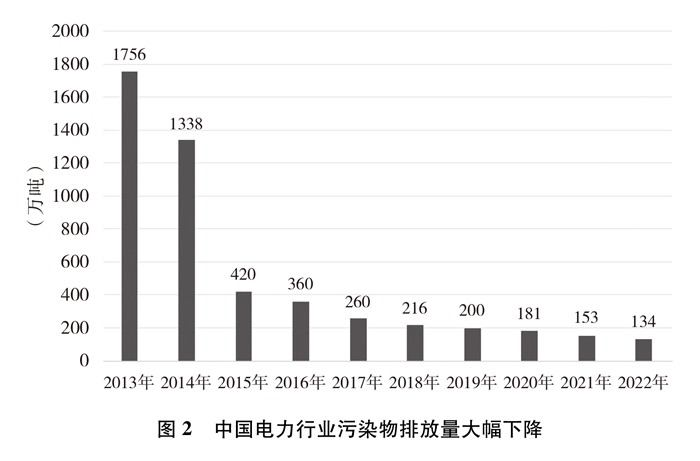
Promote the green transformation and development of oil and gas. The annual output of crude oil is stable at about 200 million tons, and the annual output of natural gas has increased by over 10 billion cubic meters for seven consecutive years. Promote the construction of green oil and gas fields, vigorously promote carbon capture, utilization and storage (CCUS) technology, and build a "near-zero" emission oil and gas field demonstration zone. We will promote the transformation and upgrading of the petroleum refining and chemical industry, and strengthen the research and development of hydrogen production from renewable energy and the preparation of chemical products from carbon dioxide hydrogenation. Scientific planning, overall and orderly promotion of refined oil quality upgrading, and phased realization of "three consecutive upgrades" from country III to country VI, the quality of refined oil reached the world advanced level, and it took less than 10 years to complete the road of refined oil quality upgrading in developed countries for nearly 30 years.
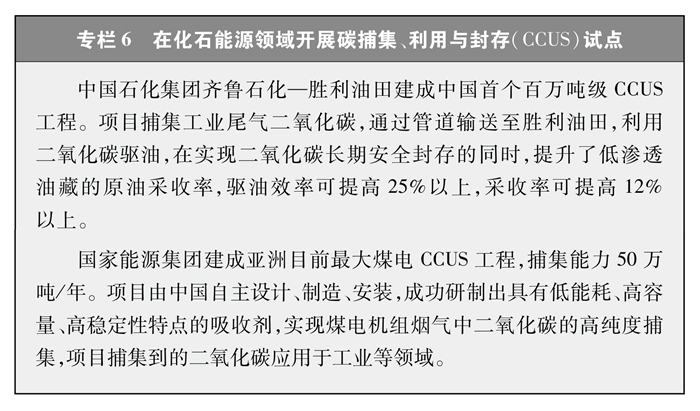
Promote the coordinated development of traditional energy and new energy. Promote the transformation of the traditional energy industry into a comprehensive energy system, and steadily implement the integration of scenery, water (storage) and scenery, fire (storage) in resource-rich areas. Construction of new energy power generation projects in coal mine industrial sites, coal mining subsidence areas, idle spaces of power plants, oil and gas mining areas, etc., through the development of offshore wind power to provide green power for oil and gas platforms, and provide clean energy for traditional energy production, development, processing and conversion. Explore the pipeline transportation of hydrogen energy, and build a comprehensive transportation energy service station integrating oil, gas, electricity and hydrogen in traditional gas stations and filling stations.
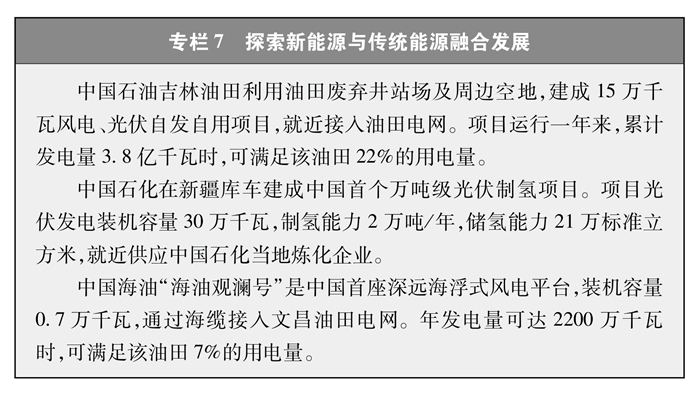
(3) Improve the toughness of the energy system
With the large-scale development of new energy and the change of power load characteristics, the operation of energy power system is facing more uncertainties, so it is urgent to enhance the flexible adjustment ability of the system and continuously improve the safe operation and risk resistance ability of the energy system.
Strengthen the interconnection of energy pipe networks. In order to strengthen the optimal allocation of resources, China has accelerated the construction of energy network infrastructure that spans the east and west, runs through the north and south, and covers the whole country, so as to enhance the capacity of large-scale long-distance energy transmission. It has formed a trans-provincial and trans-regional transmission pattern of the three major channels of "West-to-East Power Transmission", with a transmission capacity of about 300 million kilowatts, and 20 UHV DC transmission channels have been built. Constantly improve the main grid of regional power grids, and form a power grid pattern with several regional power grids as the main body and effective interconnection between regions. Basically, a "national network" of oil and gas has been formed, and the optimal allocation of oil and gas resources and the level of mutual aid and mutual protection have been significantly improved. By the end of 2023, the total mileage of the national long-distance oil and gas pipeline network was about 190,000 kilometers, including 33,000 kilometers of crude oil pipeline, 33,000 kilometers of refined oil pipeline and 124,000 kilometers of natural gas pipeline.
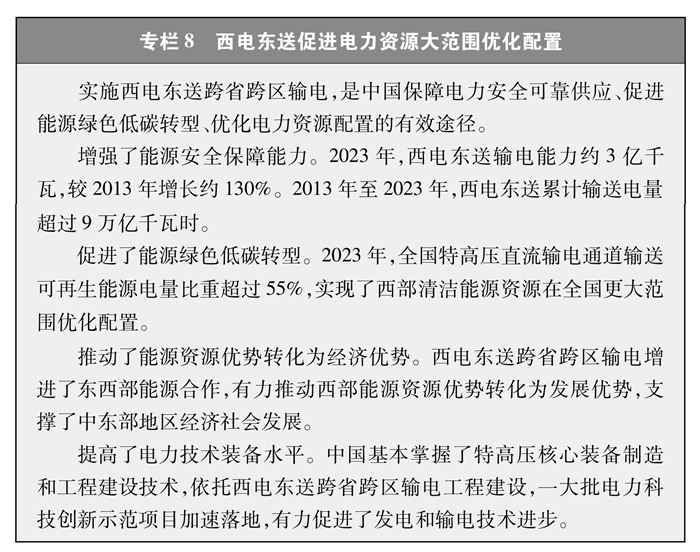
Improve the emergency capacity of energy reserves. Further improve the coal reserve system with enterprise reserves as the main body, government reserves as the supplement, and organic combination of product reserves and production capacity reserves. Gradually form an oil reserve system that combines government reserves with enterprise reserves and combines strategic reserves with commercial reserves. Accelerate the construction of a multi-level natural gas storage and peak regulation system in which local governments, gas supply enterprises, pipeline transportation enterprises and town gas enterprises are responsible for their respective responsibilities. In the past ten years, China’s natural gas storage capacity has doubled. Strengthen the energy emergency capacity building, establish a forecasting and early warning mechanism, formulate emergency plans, improve the drill system and emergency dispatch mechanism, and enhance the ability to prevent various emergencies.
Improve the regulation ability of energy system. In-depth implementation of the flexibility transformation of coal-fired power units, rational distribution of natural gas peak-shaving power stations, speeding up the construction of pumped storage power stations, and promoting the diversified development of new energy storage. By the end of 2023, the installed capacity of thermal power with flexible adjustment capacity was nearly 700 million kilowatts, the installed capacity of pumped storage was 50.94 million kilowatts, the scale of new energy storage was 31.39 million kilowatts/66.87 million kWh, and the average energy storage time was 2.1 hours. Strengthen the complementary ability between networks, and tap the demand-side response ability such as adjustable load and vehicle-network interaction.
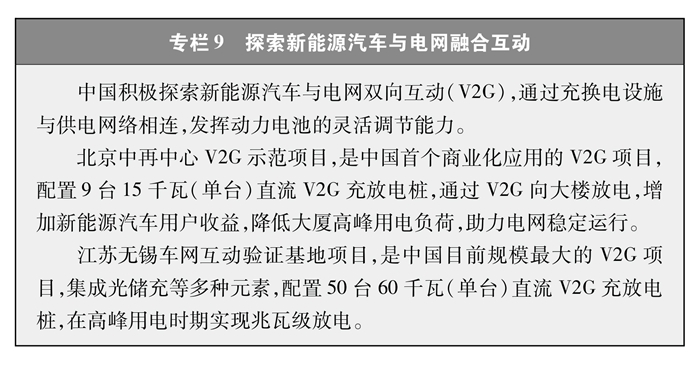
Fourth, vigorously develop new energy quality productivity
With the rapid progress of global energy green and low-carbon transformation, the trend of "technology is resources" is becoming more and more obvious. Scientific and technological innovation is the core element of accelerating energy transformation and developing new energy productivity. China has implemented the strategy of innovation-driven development, focusing on consolidating and extending advantageous industries, transforming and upgrading traditional industries, accelerating the cultivation of future industries, promoting the coordinated development of the energy industry chain in innovation chain, and constantly increasing the "new" energy content.
(A) improve the energy science and technology innovation system
Adhere to innovation as the first driving force, strengthen the top-level design and overall layout of energy science and technology innovation, and accelerate the construction of a collaborative innovation system with enterprises as the main body, market as the guidance, and deep integration of Industry-University-Research.
Strengthen collaborative innovation of energy science and technology. Focusing on major national projects such as nuclear power, oil and gas, advanced renewable energy technology, energy storage and smart grid, clean and efficient utilization of hydrogen energy and coal, we will formulate and implement energy science and technology innovation plans and strengthen the top-level design of scientific and technological innovation. Establish and improve the R&D innovation platform of the National Key Laboratory in the energy field, the National Engineering Research Center and the National Energy Administration, rely on major energy projects to promote scientific and technological innovation and transformation of achievements, and improve the new demonstration model of major energy technology and equipment coordinated by the central government, enterprises, schools and institutions.
Stimulate the vitality of innovative subjects. Strengthen the main position of energy enterprises in scientific and technological innovation, promote leading enterprises to take the lead in setting up innovation consortia, and build original technology sources and modern industrial chain chains. We will implement the system of "unveiling the list" and "horse racing" for major scientific and technological projects in the energy field, effectively stimulating the innovation vitality of R&D subjects. Improve the first (set) support policy for energy technology and equipment, and promote the demonstration and application of major technology and equipment. Support innovative enterprises to grow into the birthplace of innovation, improve support policies and public service systems, and promote the full release of enterprise innovation and entrepreneurship potential.
(2) Accelerating energy transformation and scientific and technological innovation
Aim at the forefront of energy science and technology in the world, focus on key areas and major needs of energy, strengthen scientific and technological research, vigorously develop new energy technologies and industries, and promote the green transformation and development of traditional energy industries.
Vigorously develop green energy technology. A complete R&D, design and integrated manufacturing system for wind power and photovoltaic industry chain has been built. The conversion efficiency of photovoltaic cells such as high-efficiency crystalline silicon and perovskite has set a new world record for many times, and the conversion efficiency of advanced crystalline silicon photovoltaic cells in mass production exceeds 25%. The maximum stand-alone capacity of onshore wind turbines exceeded 10 MW, and offshore wind turbines with a stand-alone capacity of 18 MW were successfully rolled off the assembly line. The whole industrial chain system of hydropower design, construction and equipment manufacturing leads the world, and the world’s largest hydropower unit with a single unit capacity of 1 million kilowatts has been put into operation in Baihetan Hydropower Station. Fully master the third-generation nuclear power technology of large-scale pressurized water reactors such as "Hualong No.1" and "Guohe No.1" and the fourth-generation nuclear power technology of high-temperature gas-cooled reactors, and start construction of the demonstration project of "Linglong No.1" small-scale pressurized water reactor. Smart grid technology is in the forefront of the world, and landmark projects such as flexible DC transmission have been built. The development of new energy storage and hydrogen energy technologies has been accelerated.
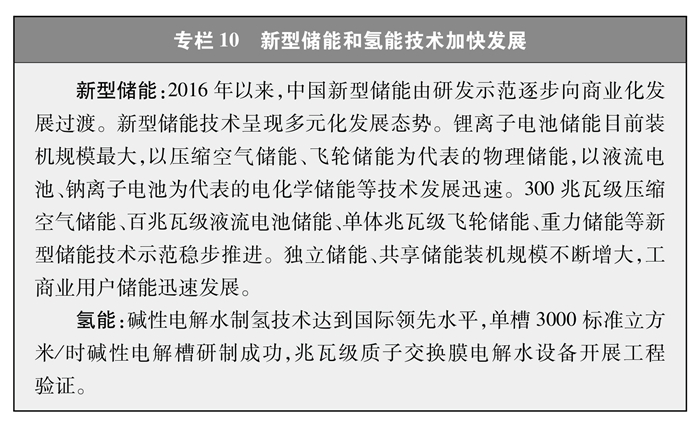
Improve the clean and efficient utilization level of traditional energy. The coal-fired power industry has promoted the application of ultra-critical coal-fired power generation and deep peak shaving technology, and the environmental protection and energy efficiency indicators have reached the world advanced level. Advanced oil and gas exploration and production technologies such as carbon dioxide flooding, horizontal drilling and shale gas development in the oil and gas field have been industrialized, and deep-sea oil and gas exploration and development technology has made remarkable progress. The world’s first 100,000-ton deep-water semi-submersible production and storage platform "Deep Sea No.1" has been put into operation, which has promoted the green transformation and upgrading of the oil and gas industry.
(3) Create a new growth point for upgrading the energy industry
Vigorously promote the deep integration of digital technology and energy industry, give birth to new technologies, new formats and new models, and insert "wings" for the advanced foundation of energy industry and the modernization of industrial chain.
Promote the transformation and upgrading of energy industry with digital intelligent technology. Accelerate the digital and intelligent upgrading of energy infrastructure, vigorously promote the construction of smart power plants, smart oil and gas fields and smart coal mines, and improve the intelligent level of enterprise decision-making, operating efficiency and service quality. Accelerate the construction of a new type of power system, share all kinds of subject information in the whole chain of source network, realize panoramic perception, global controllability, effective coordination of main distribution network and real-time regulation of various power sources, and improve the allocation efficiency of power resources and the safe operation level of the system. The terminal energy consumption link will speed up the construction of digital energy ecology, build a smart energy city and wireless city (Park), improve the coordinated regulation and intelligent level of energy consumption systems, promote a new smart energy consumption model, and promote the upgrading of green consumption with the digital economy.
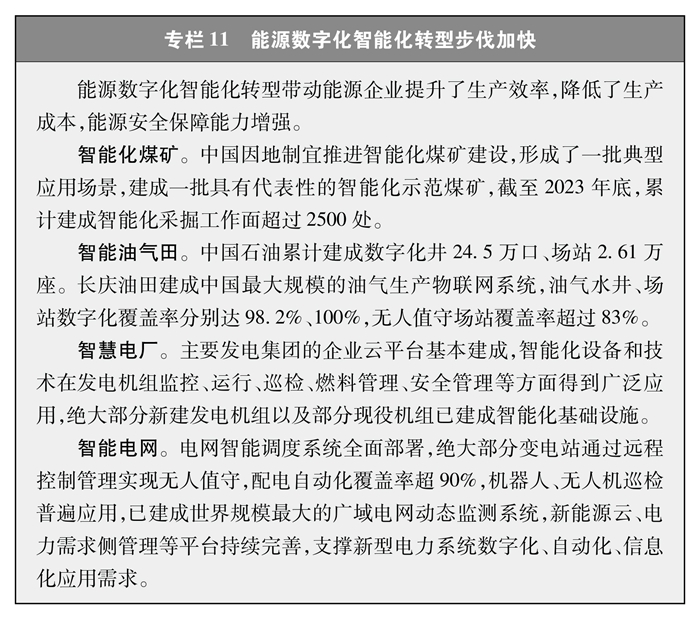
Cultivate new energy formats and new modes. Optimize and integrate the resources of power supply side, power grid side and load side, and build a new supply form with high integration and collaborative interaction between source, grid and storage. Combined with typical application scenarios such as industry, transportation and architecture, smart microgrid will be built according to local conditions to promote local consumption of new energy. Promote the construction of virtual power plants and improve the regulation capacity of power systems. Promote new modes of comprehensive energy services such as natural gas combined cooling, heating and power supply, geothermal energy, distributed new energy, new energy storage and waste heat utilization, and improve the comprehensive utilization efficiency of energy.
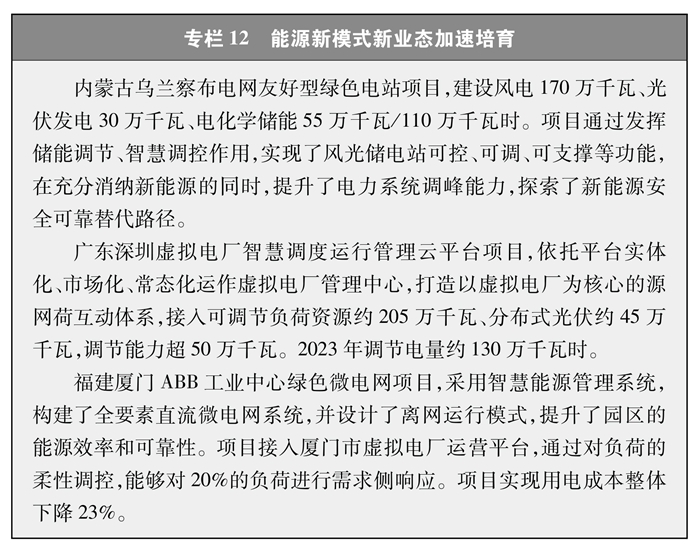
V. Promoting the modernization of energy governance
The high-quality development of energy needs to vigorously promote the modernization of energy governance and accelerate the formation of a new type of production relationship that is compatible with it. Through deepening reform, improving policies, planning guidance, legal protection and other means, China will give full play to the decisive role of the market in resource allocation, better play the role of the government, and create a good development environment for green and low-carbon energy transformation.
(1) Building a fair, open and effectively competitive energy market.
We will further promote the reform of energy marketization, speed up the construction of an effective competitive market structure and system, improve the mechanism in which energy prices are mainly determined by the market, strengthen the construction of a unified large market, break through the "obstruction" of the energy market, promote the efficient and smooth operation of the market, and create a stable, fair, transparent and predictable good environment for various business entities.
Continue to deepen the reform of energy marketization. The situation of unified purchase and marketing of power grid has basically broken down, market competition has been fully introduced in power generation and sales, social capital investment has been introduced in power distribution, and new subjects such as integrated energy service providers, virtual power plants and new energy storage enterprises have flourished. Private enterprises have become the main force in the new energy industry. Private enterprises account for about 60% of the wind turbine manufacturers in China, and most of the photovoltaic equipment manufacturers are private enterprises. The reform of the oil and gas system has been deepened, and the national pipe network company has been established, gradually forming a market pattern of multi-agent and multi-channel supply of upstream oil and gas resources, efficient collection and transportation of the middle unified pipe network and full competition in the downstream sales market.

Building a unified national energy market. Accelerate the construction of a unified national electricity market system, with efficient cooperation among provinces, regions and provinces, and organic connection between medium and long-term spot and auxiliary service transactions. Set up power trading centers, oil and gas trading centers and coal trading centers, and build an open and transparent energy trading platform with perfect functions. The market-oriented electricity consumption in the whole country increased from 17% in 2016 to 61.4% in 2023. In 2023, the market-oriented electricity consumption of wind power photovoltaic accounted for 47% of the total power generation, which effectively promoted the optimal allocation of power resources and the efficient use of renewable energy.

Improve the energy price formation mechanism. Deepen the market-oriented reform of energy prices, promote all kinds of power sources to participate in the market in an orderly manner, constantly improve the policy system of new energy on-grid tariffs, and fully liberalize the industrial and commercial sales tariffs. Establish a coal capacity electricity price mechanism to promote the transformation of coal power from basic power supply to supporting regulatory power supply. We will introduce a series of step-by-step electricity price policies for high-energy-consuming industries to promote energy conservation and emission reduction, improve the time-of-use electricity price policy, and guide users to cut peaks and fill valleys and use electricity at wrong peaks. Build a natural monopoly price supervision system with "permitted cost+reasonable income" as the core and equal emphasis on incentives and constraints. Improve the formation mechanism of refined oil prices that flexibly reflects the changes in crude oil prices in the international market and domestic supply and demand situation. Orderly promote the price marketization reform of natural gas gate stations. The medium and long-term coal contract system and the market price formation mechanism have been continuously improved.
(B) to strengthen government guidance and services
Accelerate the transformation of government functions, give play to the strategic guiding role of national development planning, strengthen the coordination of macro policies such as finance, taxation, investment and financing, strengthen market supervision, optimize public services, and ensure the organic unity of efficiency and fairness in energy transformation.
Strengthen planning guidance. Implement the strategy of energy production and consumption revolution, formulate a series of special plans such as medium-and long-term planning, five-year planning and renewable energy development, make overall arrangements for energy green and low-carbon development, and give play to the guiding role of planning in energy transformation, layout of major energy projects, allocation of public resources and investment of social capital. Strengthen the planning connection between energy and ecological environment protection, land and space, and strengthen the element guarantee of green and low-carbon transformation.
Strengthen policy support. Adapt to the needs of green and low-carbon transformation and improve the standard system related to clean energy. Formulate a guidance catalogue for green and low-carbon transformation industries, and formulate and improve industrial support policies according to the catalogue. Increase support for clean and low-carbon energy projects from central budget investment, local government special bonds and national green development fund. Build a green financial system, guide financial institutions to increase green loans under the principle of marketization and rule of law, and support enterprises to issue green bonds. Optimize the approval and filing process of clean and low-carbon energy projects and simplify the management procedures of distributed energy investment projects.
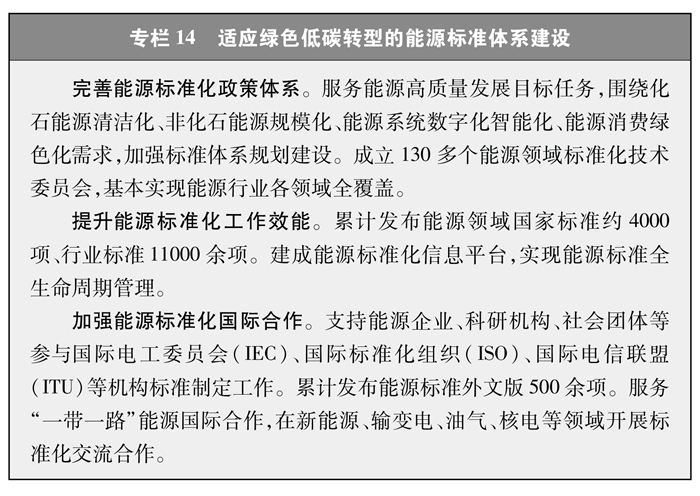
Improve the effectiveness of supervision. We will improve the supervision system of natural monopoly links in the energy field and promote the fair opening of power grids and oil and gas pipeline network facilities to third parties without discrimination. We will continue to strengthen supervision over market transactions, price mechanisms, information disclosure, etc., promptly correct behaviors that disrupt market order, and ensure the effective implementation of market rules. We will strengthen supervision over the implementation of major energy plans, policies and projects, and increase supervision over renewable energy consumption protection, the construction and operation of regulated power sources, and the consolidation and upgrading of rural power grids. Innovate the way of energy supervision, establish a new supervision mechanism based on credit, and promote the "internet plus" supervision. Establish and improve power safety supervision systems such as power grid safety risk management and control, power emergency, dam safety and network safety risk management and control to ensure the safe and stable operation of power system and reliable power supply.
(3) Strengthening the legal protection of energy transformation
Adhere to scientific legislation, strict law enforcement, and fair justice, give play to the role of the rule of law in ensuring stability, stability, and long-term benefits, and improve the level of legalization of energy governance.
Improve the legal system. China has established a legal system of energy transformation based on energy conservation law and renewable energy law, supported by clean production promotion law, circular economy promotion law and temporary regulations on carbon emission trading management. Promote the compilation of eco-environmental code, speed up the formulation of energy law, revise renewable energy law and electricity law, further improve the laws and regulations system for promoting green production and consumption, and strengthen the incentive and restraint systems such as saving energy, upgrading the development goals of non-fossil energy, giving priority to the use of renewable energy and promoting green energy consumption.
Improve the level of administration according to law. We will further promote the construction of a government ruled by law and run the rule of law through the whole process of energy strategy, planning, policy and standard formulation, implementation, supervision and management. In the energy field, we will fully implement the publicity system of administrative law enforcement, the whole process recording system, and the legal review system of major law enforcement decisions, improve the benchmark system of administrative discretion, and strictly regulate fair and civilized law enforcement. Deepen the reform of the administrative reconsideration system, optimize the administrative reconsideration acceptance procedures, evidence rules and trial modes, and protect the legitimate rights and interests of enterprises and people in energy production and consumption activities according to law. Carry out in-depth publicity and education on energy law, fully implement the responsibility system of "who enforces the law and popularizes the law", and promote the whole society to consciously fulfill its green consumption obligations.
Strengthen energy judicial services. Improve the judicial service measures for high-quality energy development in an all-round way, and promote the goal of carbon neutrality in peak carbon dioxide emissions with fair justice. The Supreme People’s Court has set up an environmental resources court, and there are 2,800 specialized environmental resources courts and organizations in China, which specialize in hearing cases related to the construction of ecological civilization and the rule of law. Issue relevant judicial interpretations and guidance, and clarify the application of law and the guidance of adjudication rules in the trial of cases related to energy transformation.
Sixth, help build a community of human destiny.
Maintaining energy security and coping with climate change are common challenges facing the world, and accelerating the development of green and low-carbon energy is a common opportunity for the world. While continuing to promote its own energy transformation, China actively promotes and contributes to the global energy transformation, insists on joint construction and sharing, and seeks global energy sustainable development with other countries, thus contributing to the establishment of a fair, just, balanced and inclusive global energy governance system.
(A) China provides new kinetic energy for global green development.
China actively practices the concept of green development, unswervingly promotes the transformation of development mode, and extensively carries out international energy cooperation, thus injecting "China power" into global green development.
China’s energy green development has become the engine of global energy transformation. Since 2013, China’s newly installed renewable energy accounts for more than 40% of the world’s newly installed renewable energy annually, and in 2023, the newly installed renewable energy accounts for more than half of the world’s newly installed renewable energy. The report "Renewable Energy in 2023" issued by the International Energy Agency (IEA) points out that China is a global leader in the field of renewable energy and the main driving force for the rapid and large-scale growth of global renewable energy. From 2014 to 2023, the proportion of global non-fossil energy consumption increased from 13.6% to 18.5%, of which the incremental contribution rate of non-fossil energy consumption in China was 45.2%.
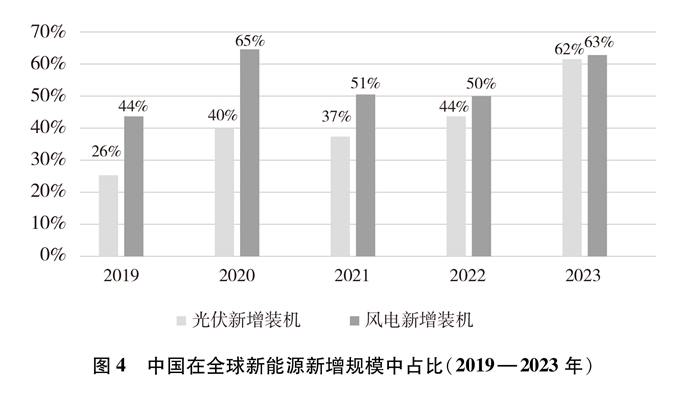
China’s new energy industry provides green power for the whole world. Relying on continuous technological innovation, perfect industrial chain supply chain system, full market competition and super-large-scale market advantages, China has achieved rapid development of new energy industry, enriched global supply, eased global inflationary pressure, and made contributions to coping with climate change and enhancing human welfare for all countries in the world. Photovoltaic modules and wind power equipment produced in China have created conditions for renewable energy to be widely and economically utilized in more and more countries. According to the report of the International Renewable Energy Agency, in the past 10 years, the average kilowatt-hour cost of global wind power and photovoltaic power generation projects has decreased by more than 60% and 80% respectively, which is largely attributed to the contribution of China.
Opening wider to the outside world in China creates new opportunities for deepening international cooperation in clean energy. China continues to create a market-oriented, rule-based and international first-class business environment, actively promotes the liberalization and facilitation of energy trade and investment, and provides opportunities for foreign-funded enterprises to share the dividend of China’s energy transformation. The system of national treatment plus negative list management before entry has been fully implemented, and the access of foreign investment in the energy field except nuclear power plants has been fully liberalized. Introduce a catalogue of industries to encourage foreign investment and increase policy support for foreign investment in clean energy and other fields. The energy investment scale of multinational companies such as General Electric, Bibi and Siemens has increased steadily in China, and foreign-funded projects such as electricite de france offshore wind power project, Shanghai Tesla electric vehicle manufacturing project and Nanjing LG new energy battery project have successively landed in China.
(2) Promote the "One Belt, One Road" green energy cooperation.
China adheres to the principle of cooperation, co-construction and sharing, upholds the concept of openness, greenness and honesty, aims at high standards, sustainability and benefiting people’s livelihood, and continues to deepen energy transformation cooperation with other countries under the framework of jointly building the Belt and Road Initiative, making "green" the background of energy cooperation in the Belt and Road Initiative and realizing sustainable development together.
Continue to promote the "Belt and Road" green energy cooperation. China issued the "Opinions on Promoting the Green Development of the Belt and Road" and other policy documents, and actively expanded cooperation in the field of green energy with countries that jointly built the Belt and Road. In 2021, China announced that it would not build new overseas coal-fired power projects, and green and low-carbon energy has become the focus of China’s national energy cooperation. China has cooperated with more than 100 countries and regions in green energy projects, and a large number of landmark energy projects and "small but beautiful" projects benefiting people’s livelihood have taken root, effectively solving the problems of difficult and expensive electricity consumption in the host country and providing clean, safe and reliable energy supply solutions for the host country.
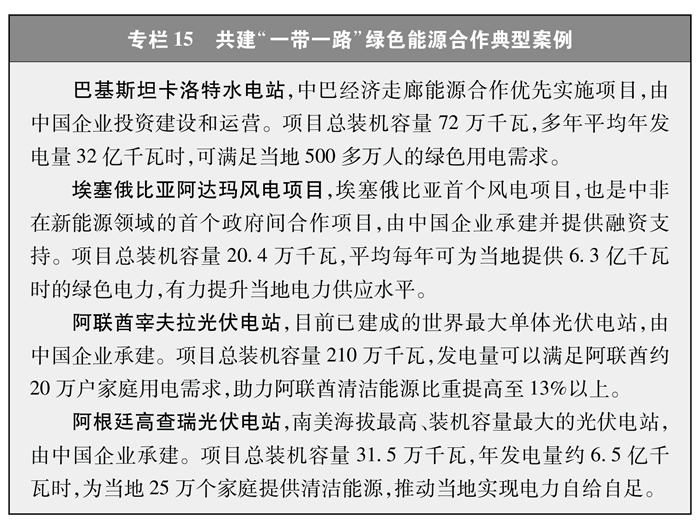
Work together to build a high-level energy cooperation platform. China advocates the establishment of "One Belt, One Road" energy partnership, with 33 member countries covering six continents, including Asia and Africa. Six regional energy cooperation platforms, including China-ASEAN, China-Arab League, China-African Union, China-Central and Eastern Europe, China-Central Asia and the Asia-Pacific Economic Cooperation (APEC) Sustainable Energy Center, have been promoted to be effective. Establish a meeting mechanism of energy ministers of the Shanghai Cooperation Organization. Focus on energy security, energy transformation, energy accessibility and energy sustainable development issues, and contribute to China’s plan for global energy governance reform.
(3) jointly promote the sustainable development of global energy.
In recent years, the international situation has become more complicated, and various forms of green barriers have increased, making it more difficult to maintain energy security under the conditions of stable and open global energy industry chain supply chain. Facing the new situation and changes, China, as a responsible developing country, is willing to work with other countries to improve the clean energy industry chain supply chain, share knowledge and experience, work together to promote the green and low-carbon transformation of energy, and make unremitting efforts for the sustainable development of global energy and the building of a community of human destiny.
— — Work together to deepen pragmatic cooperation in energy transformation. China adheres to open cooperation, mutual benefit and win-win, and actively promotes the implementation of global development initiatives. China is committed to improving the bilateral and multilateral cooperation mechanism in the energy field, strengthening the exchange of energy transformation policies and experiences, promoting green and low-carbon technology cooperation and capacity building, and lighting up the beautiful world with green energy. China opposes the generalization of national security and restricts normal international development cooperation under various pretexts. China is willing to work with the international community to explore new energy sources that will benefit mankind and create a sustainable energy future.
— — Jointly safeguard the stability and smoothness of the global energy industry chain supply chain. China has always adhered to true multilateralism, opposed any form of unilateralism and trade protectionism, and opposed all forms of "decoupling and chain breaking" and "small courtyard and high wall", and is committed to maintaining the stability and smoothness of the global energy industry chain supply chain. China is willing to strengthen dialogue and communication with other countries, jointly promote the liberalization and facilitation of trade and investment, and jointly build a safe, stable, smooth, efficient, open, inclusive and mutually beneficial global energy industry chain supply chain system. Great powers should pay more attention to the future of the earth and mankind, ensure global energy security, promote green development, maintain market order in a responsible manner, and demonstrate the responsibility and responsibility of great powers.
— — Work together to improve global energy accessibility. Eliminating poverty is the common responsibility of the international community, and ensuring the supply of energy such as electricity is the basic condition for eliminating poverty and reducing the gap in underdeveloped areas. China has implemented the largest, strongest and most populous poverty alleviation project in human history, and completely eliminated absolute poverty. China is willing to take practical actions with other countries to implement the UN Agenda for Sustainable Development in 2030, help underdeveloped countries and regions to improve their energy supply security capabilities, and support relevant countries to promote the application of clean electricity such as renewable energy, so as to achieve the development goal of "ensuring affordable, reliable and sustainable modern energy for all".
— — Work together to meet the challenges of global climate change. The earth is the home for human survival, and climate change is a common challenge for all countries. China firmly implements the national strategy of actively responding to climate change, declares peak carbon dioxide emissions’s goal of carbon neutrality, and contributes to the global response to climate change with practical actions. China will join hands with other countries to adhere to the principles of fairness, common but differentiated responsibilities and respective capabilities, implement the objectives and tasks of the Paris Agreement, and build a fair and reasonable global climate governance system with win-win cooperation. Developed countries should provide financial, technological and capacity-building support for developing countries to deploy renewable energy, and help developing countries meet the dual challenges of energy supply security and green and low-carbon transformation, and jointly move towards a greener, inclusive and sustainable future.
Concluding remarks
Looking back on the past decade, China has unswervingly taken the road of green and low-carbon energy transformation and achieved remarkable results. However, energy transformation is an extensive and profound systematic economic and social change, and it is a long-term strategic task, which needs to strive for progress steadily and make achievements for a long time under the guidance of the new energy security strategy.
China has formulated a medium-and long-term development plan. By 2035, China will basically realize socialist modernization, with green energy production and consumption widely formed, non-fossil energy will accelerate to the main energy, and the new power system will provide strong support for energy transformation, and the goal of beautiful China will basically be realized. By the middle of this century, China will be fully built into a modern socialist power, a clean, low-carbon, safe and efficient new energy system will be fully built, the energy utilization efficiency will reach the advanced level in the world, and non-fossil energy will become the main energy, supporting the goal of carbon neutrality by 2060.
The earth is the common home of mankind, and a clean and beautiful world with bluer sky, greener mountains and clearer water is the common expectation of the villagers on the earth. To meet the challenge of climate change and realize the sustainable use of energy, it is necessary to accelerate the pace of global energy transformation. This green revolution is related to everyone’s well-being and future generations. All countries should join hands to protect the earth’s homeland on which human beings depend.
China respects, conforms to and protects nature, always upholds the concept of building a community of human destiny, accelerates the development of green and low-carbon energy, and promotes the establishment of a fair, just, balanced and inclusive global energy governance system. China is willing to work with the international community to discuss energy cooperation plans, jointly address global climate change, jointly promote the harmonious coexistence between man and nature, and jointly build a clean and beautiful earth home.
关于作者